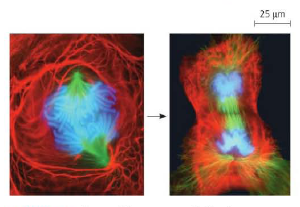
In life's structural hierarchy, the cell has a special place as the lowest level of organization that can perform all activities required for life. Moreover, the activities of organisms are all based on the activities ofcells. For instance, the division of cells to form new cells is the basis for all reproduction and for the growth and repair of multicellular organisms (Figure 1). To cite another example, the movement of your eyes as you read this line is based on activities of muscle and nerve cells. Even a global process such as the recycling ofcarbon is the cumulative product ofcellular activities, including the photosynthesis that occurs in the chloroplasts ofleafcells. Understanding how cells work is a major focus of biological research.
All cells share certain characteristics. For example, every cell is enclosed by a membrane that regulates the passage of materials between the cell and its surroundings. And every cell uses DNA as its genetic information. However, we can distinguish between two main forms ofcells: prokaryotic cells and eukaryotic cells. The cells of two groups of microorganisms called bacteria and archaea are prokaryotic. All other forms of life, including plants and animals, are composed of eukaryotic cells.

Aeukaryotic cell is subdivided by internal membranes into various membrane-enclosed organelles, such as the ones you see in image above and the chloroplast you saw in Figure on Exploring Levels of Biological Organization. In most eukaryotic cells, the largest organelle is the nucleus, which contains the cell's DNA. The other organelles are located in the cytoplasm, the entire region between the nucleus and outer membrane of the cell. As image above also shows, prokaryotic cells are much simpler and generally smaller than eukaryotic cells. In a prokaryotic cell, the DNA is not separated from the rest of the cell by enclosure in a membrane-bounded nucleus. Prokaryotic cells also lack the other kinds of membrane-enclosed organelles that characterize eukaryotic cells.
But whether an organism has prokaryotic or eukaryotic cells, its structure and function depend on cells.






No comments:
Post a Comment